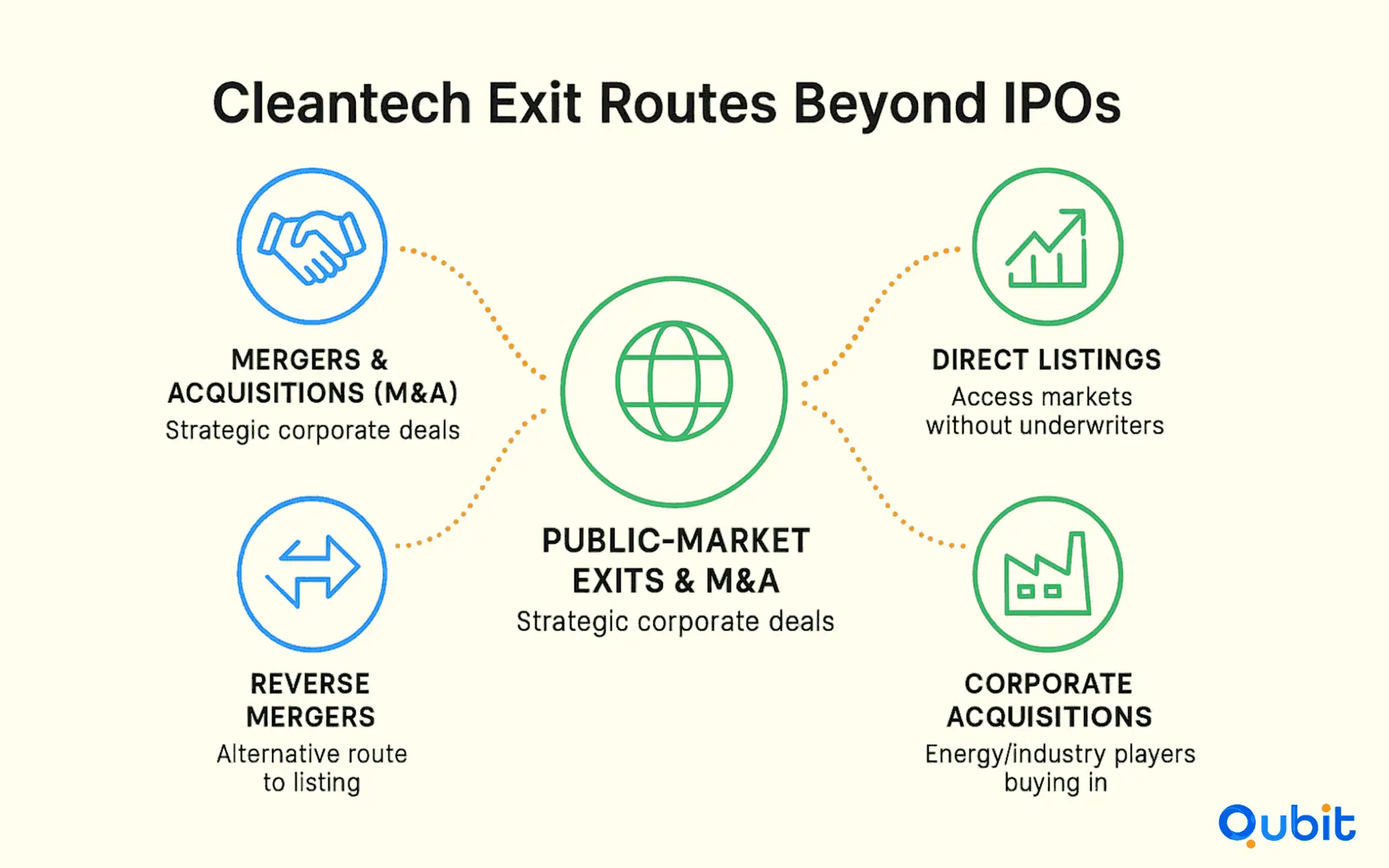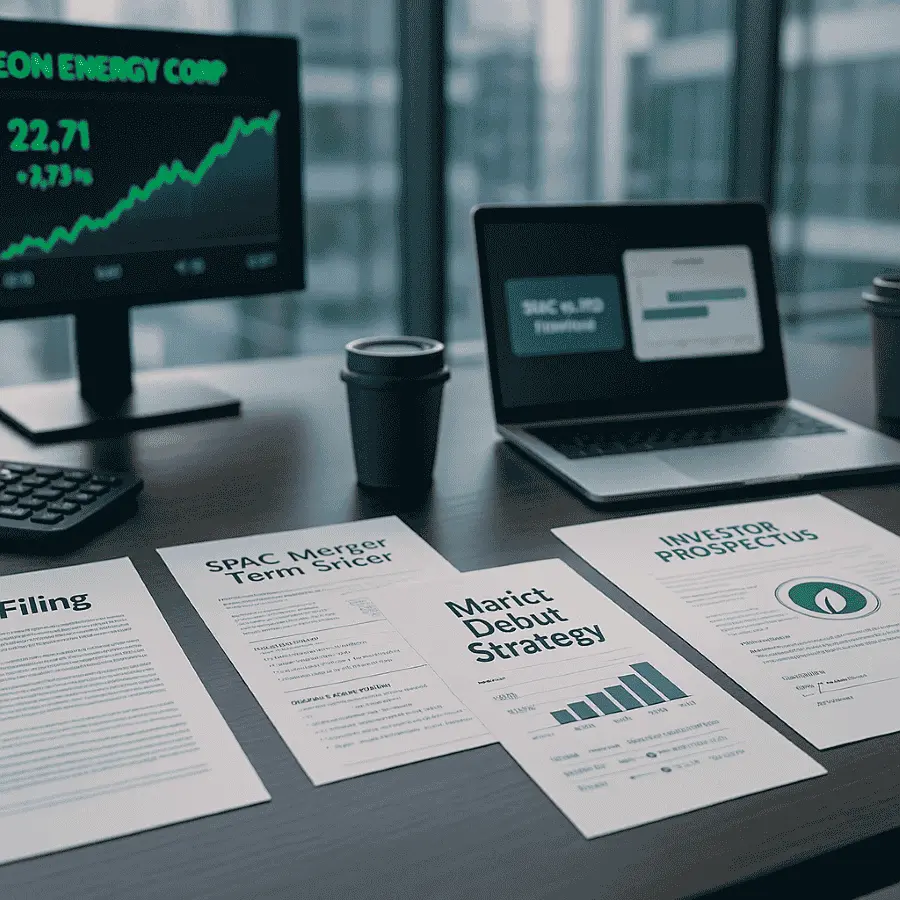The cleantech sector stands at a pivotal moment in 2025. As global investment in climate solutions continues to surge, founders and investors are increasingly focused on the endgame: how to achieve meaningful, scalable exits.
Initial public offerings (IPOs), special purpose acquisition companies (SPACs), and other public-market routes have emerged as the primary vehicles for unlocking value and fueling the next wave of innovation. But as the capital markets evolve, so too do the strategies, risks, and opportunities for cleantech companies eyeing a public debut.
In this article you will learn about the cleantech IPO and SPAC and how you can go about the process smoothly
Let's get started!
The Evolving Cleantech Exit Landscape
Over the past five years, public-market exits in cleantech have accelerated, driven by a convergence of policy support, technological maturity, and investor demand for sustainable assets. According to recent data, more than 289 climate tech companies have exited via M&A, SPAC, or IPO since 2020, with exit activity rising 70% year-over-year during the last two years. This momentum is reshaping how founders, venture capitalists, and corporate backers approach growth and liquidity planning.
Yet, the only certainty in this decade is uncertainty. The cleantech sector is navigating a period defined by three major tipping points: supply economics survival, surging power demand, and a renaissance in resilience and adaptation technologies. These forces are influencing both the timing and structure of public-market exits, as well as the types of companies that succeed on the public stage.
IPOs: The Classic Route for Cleantech Scale-ups

Why IPOs Remain Attractive
For mature cleantech companies with robust revenues, proven technology, and strong growth prospects, an IPO remains the gold standard for accessing large pools of capital, enhancing brand credibility, and providing liquidity to early investors. The IPO window has reopened in 2025, with several high-profile cleantech offerings drawing significant institutional and retail interest.
Key advantages of IPOs for cleantech firms include:
- Access to Deep Capital Markets: Public listings unlock capital for large-scale manufacturing, R&D, and global expansion.
- Enhanced Visibility: Being a public company raises profile with customers, partners, and policymakers.
- Liquidity for Investors: Early backers can realize returns, recycling capital into new ventures.
Challenges and Considerations
However, the IPO process is demanding. Cleantech companies face heightened scrutiny on financials, governance, and ESG performance. The sector’s long development cycles and capital intensity can make it harder to meet the quarterly growth expectations of public market investors.
Moreover, policy shifts, such as changes in incentives or tariffs, can introduce volatility into public valuations. Your examination of cleantech startup fundraising strategies reveals a broad framework of funding dynamics, placing you within the context of both challenges and opportunities in the cleantech sector.
SPACs: Agility and Sector Focus
The SPAC Resurgence
SPACs have become a dynamic force in global capital markets, offering an alternative route for cleantech companies to go public. In Q1 2025 alone, 19 SPAC IPOs raised $3.1 billion globally, with 80% of new SPACs led by experienced, repeat sponsors. The average SPAC deal size has expanded, and cleantech remains a favored target sector, accounting for a significant share of announced SPAC activity.
SPACs offer several unique advantages:
- Speed to Market: SPAC mergers can bring companies public faster than traditional IPOs.
- Sponsor Expertise: Many SPACs are led by sector experts or former executives, providing valuable guidance and networks.
- Flexible Deal Structures: SPACs can tailor transaction terms to suit the needs of both founders and investors.
The “Python Digesting an Antelope” Phenomenon
The SPAC boom of 2020-2021 created a backlog of deals, with hundreds of SPACs searching for targets and large sums of capital seeking a sustainable home in cleantech. While the market has matured and become more selective, the appetite for innovative, high-growth climate tech remains strong. SPACs have proven especially popular for companies in emerging areas like battery storage, hydrogen, and mobility, where rapid scaling and capital needs align with the SPAC model.
Risks and Market Realities
Despite their advantages, SPACs are not without challenges. The market has seen increased regulatory scrutiny, and not all de-SPAC mergers have performed well post-listing. Companies must be prepared for public market discipline, transparent disclosures, and the operational rigor required of listed entities.
Other Public-Market Routes and M&A
While IPOs and SPACs dominate headlines, mergers and acquisitions (M&A) remain a significant exit route for cleantech companies. Corporate acquirers—especially in energy, chemicals, and industrials—are actively seeking innovative startups to bolster their sustainability portfolios. In fact, 30% of all deals in the 2025 Global Cleantech 100 involved a corporation, reflecting a portfolio strategy around clean fuels, hydrogen, and application-specific solutions.
Additionally, direct listings and reverse mergers are occasionally used, though less commonly, to access public markets without the traditional underwriting process.
What Makes a Cleantech Company “IPO-Ready”?
To succeed on public markets, cleantech companies must demonstrate:
- Strong Revenue Growth: Predictable, recurring revenues with a clear path to profitability.
- Scalable Technology: Proven solutions that address large, urgent markets—such as clean fuels, grid resilience, or resource efficiency.
- Robust ESG Credentials: Transparent reporting and alignment with sustainability standards are now table stakes for public investors.
- Operational Excellence: A seasoned management team and robust governance structures.
Companies that can compete on market economics, rather than relying solely on policy support, are better positioned for long-term success post-IPO.
Trends Shaping Cleantech Public-Market Exits in 2025
- Resilience and Adaptation: Technologies addressing climate resilience, water, and extreme weather are entering the mainstream, attracting public and private capital.
- Clean Fuels and Molecules: The rise of hydrogen, ammonia, and sustainable aviation fuels is driving both corporate investment and public-market appetite.
- Power Demand and Electrification: Solutions supporting grid stability, energy efficiency, and electrification of transport and industry are in high demand.
- Global Policy Uncertainty: Shifting political landscapes and incentive structures are influencing both timing and investor appetite for public listings.
Strategic Considerations for Founders and Investors
- Timing the Market: The IPO and SPAC windows can open and close quickly. Companies should maintain readiness and monitor market signals.
- Building the Right Team: Public companies require experienced leadership, investor relations, and compliance capabilities.
- Engaging with Corporate Partners: Strategic investments and partnerships can enhance credibility and support a successful transition to public markets.
- Preparing for Volatility: Cleantech valuations can be sensitive to policy changes, commodity prices, and macroeconomic shifts. A robust risk management strategy is essential.
Conclusion
IPOs, SPACs, and other public-market routes are reshaping the cleantech exit landscape in 2025. While the sector faces ongoing uncertainty, the appetite for climate solutions is undeniable. Companies that combine technological maturity, market traction, and operational excellence are well-positioned to capitalize on public-market opportunities, fueling the next wave of sustainable growth and innovation.
At Qubit Capital, we specialize in helping startups secure the funding they need to thrive. If you're ready to elevate your approach, explore our Fundraising Assistance service. Let us help you turn your vision into reality.
Key Takeaways
- Public-market exits via IPOs and SPACs are increasingly common for cleantech companies with proven scale and strong growth prospects.
- SPACs offer speed, sector expertise, and flexible deal structures, but require readiness for public scrutiny and operational discipline.
- Corporate M&A remains a significant exit route, especially for companies with strategic fit in energy, fuels, and resilience.
- Success on public markets depends on robust revenue growth, scalable technology, ESG leadership, and the ability to compete on market economics.
- Timing, team strength, and risk management are critical for navigating the evolving public-market landscape in cleantech.
Frequently asked Questions
What are the main differences between an IPO and a SPAC for cleantech companies?
An IPO is a traditional public listing process, often slower and more demanding, but offers broad access to capital markets. A SPAC merger is typically faster, with more flexibility and sector-specific sponsor expertise, but can bring post-listing volatility and regulatory complexity.


 Back
Back



